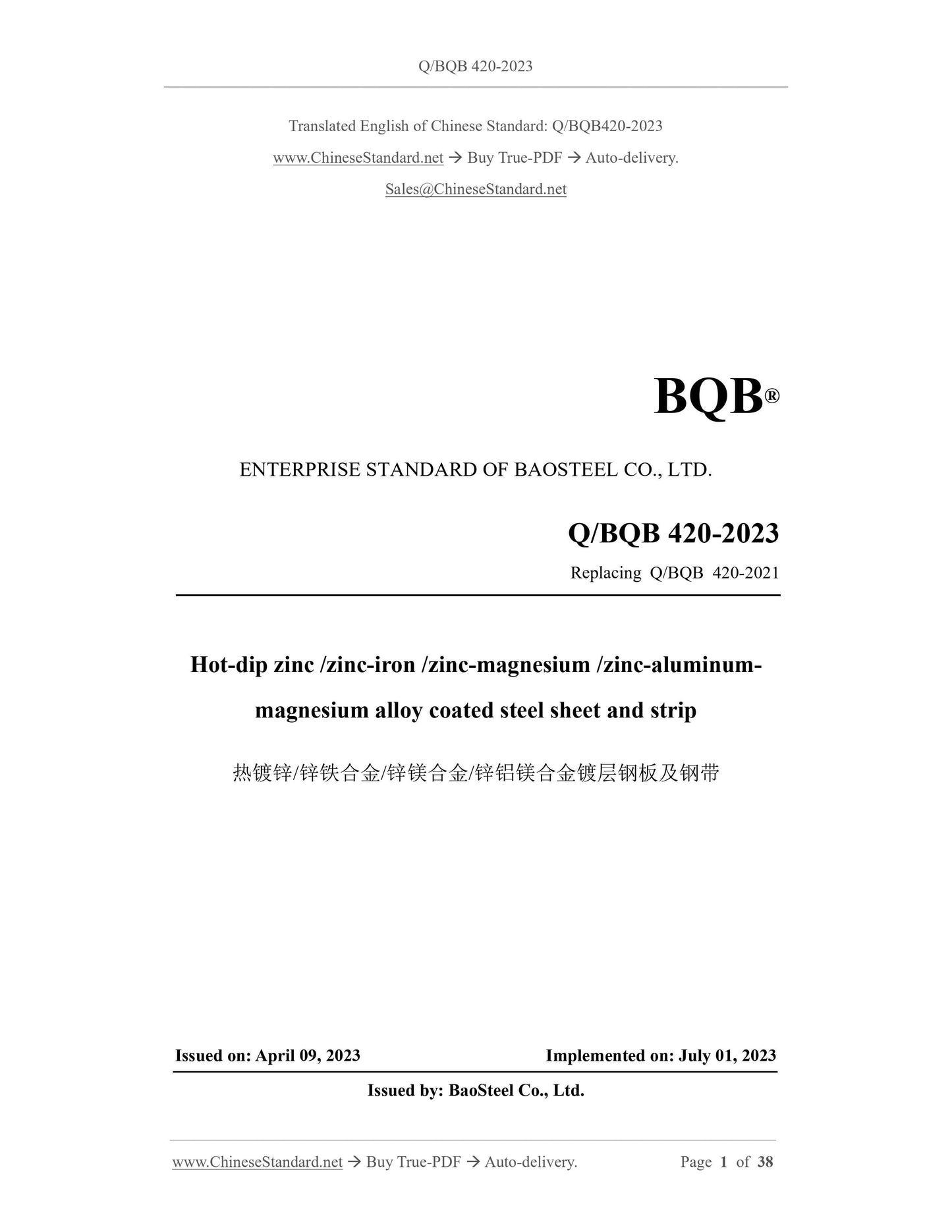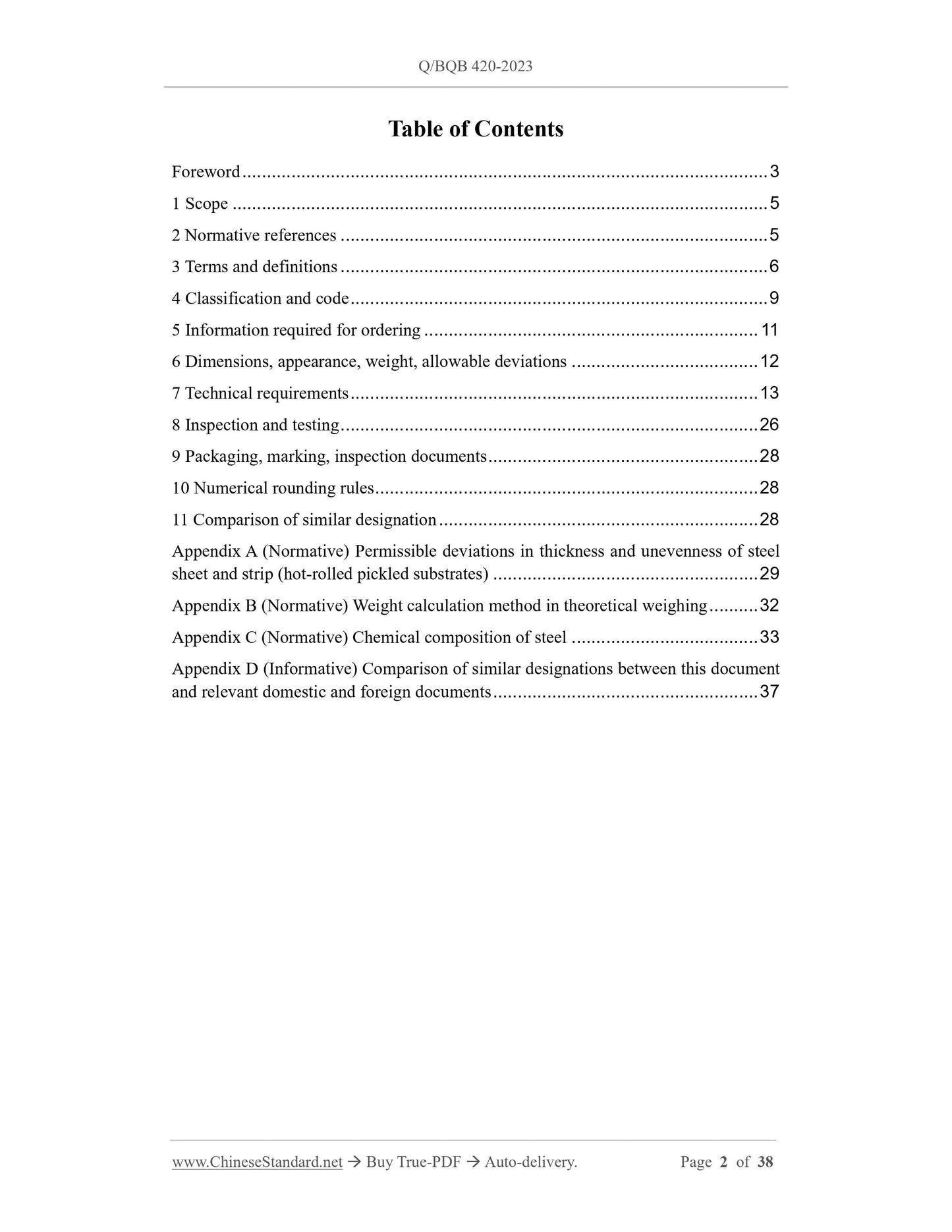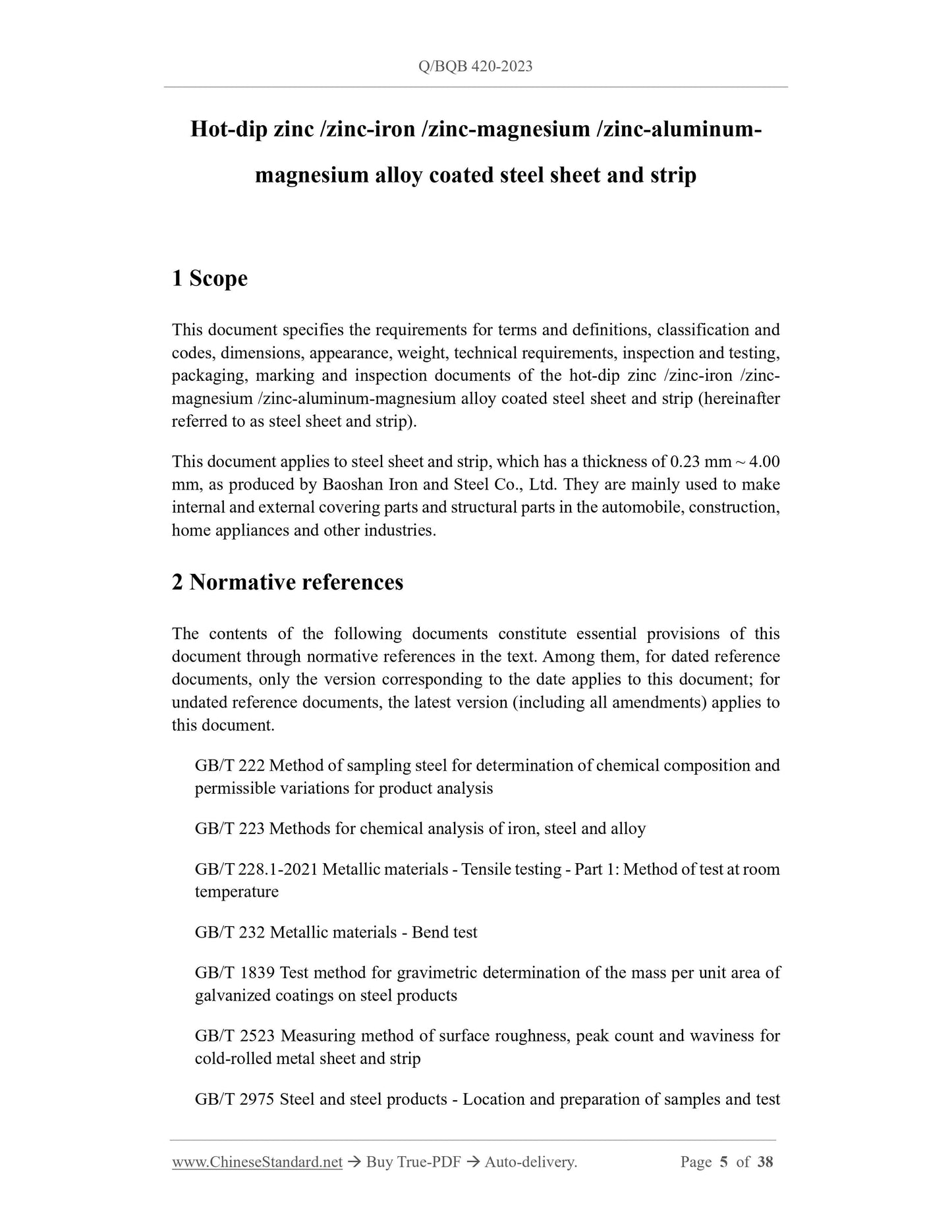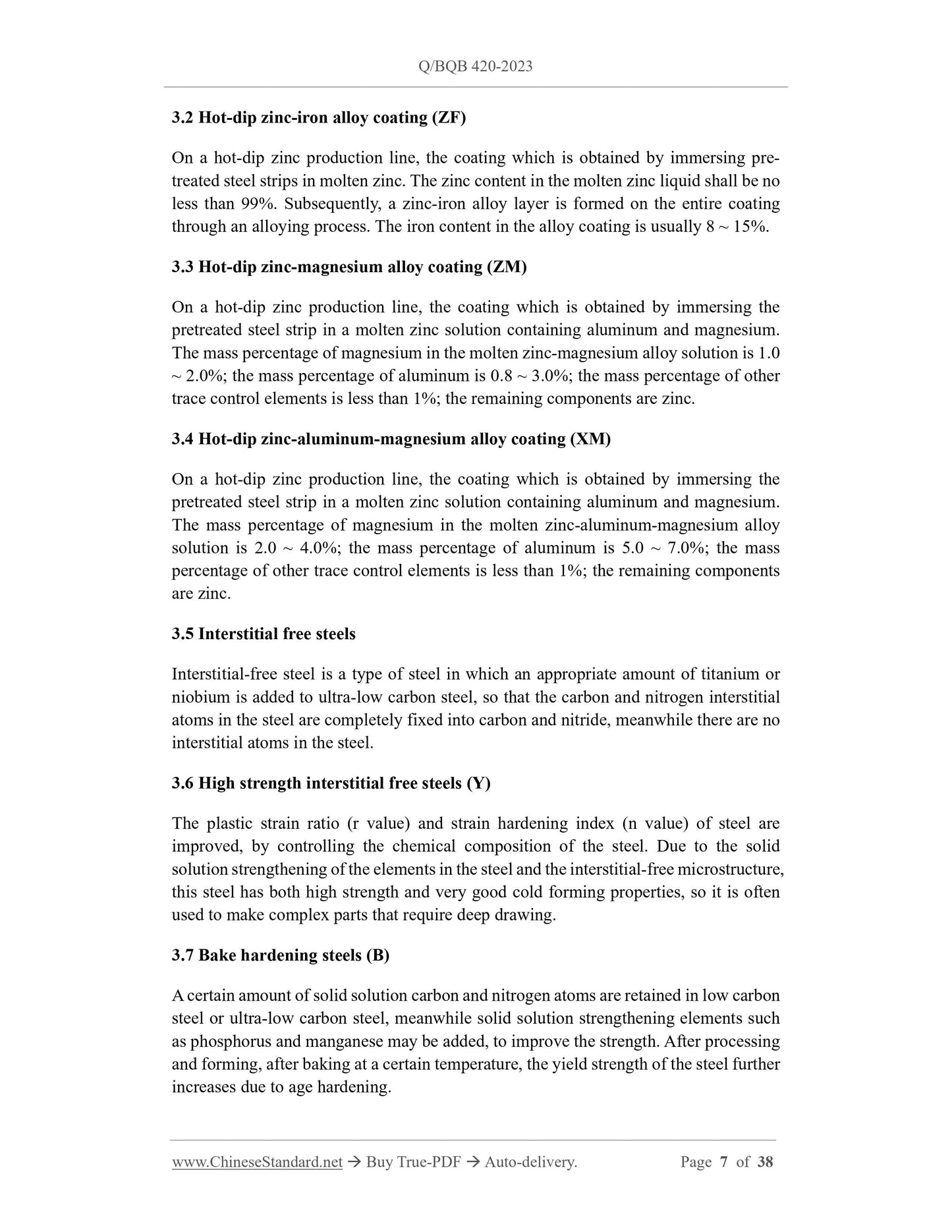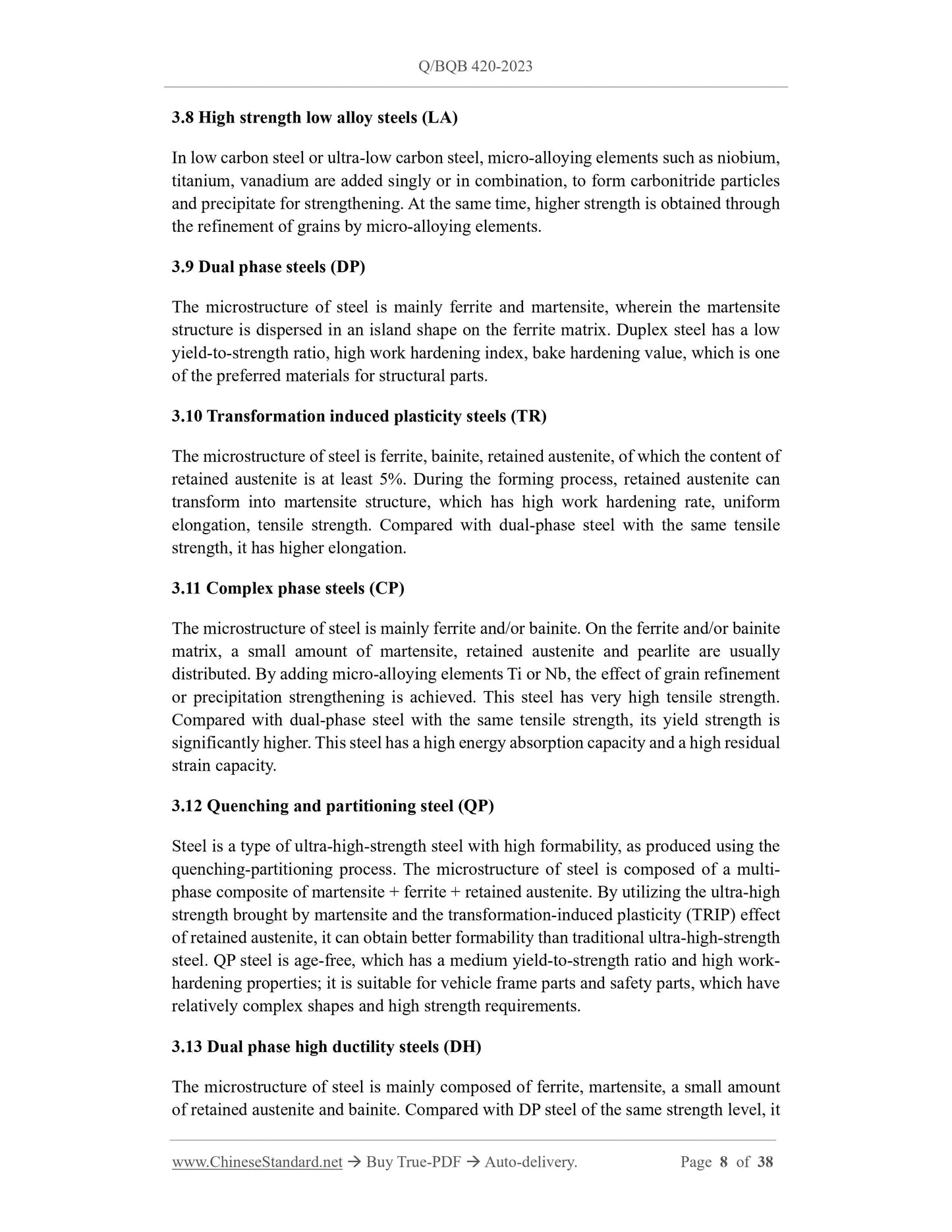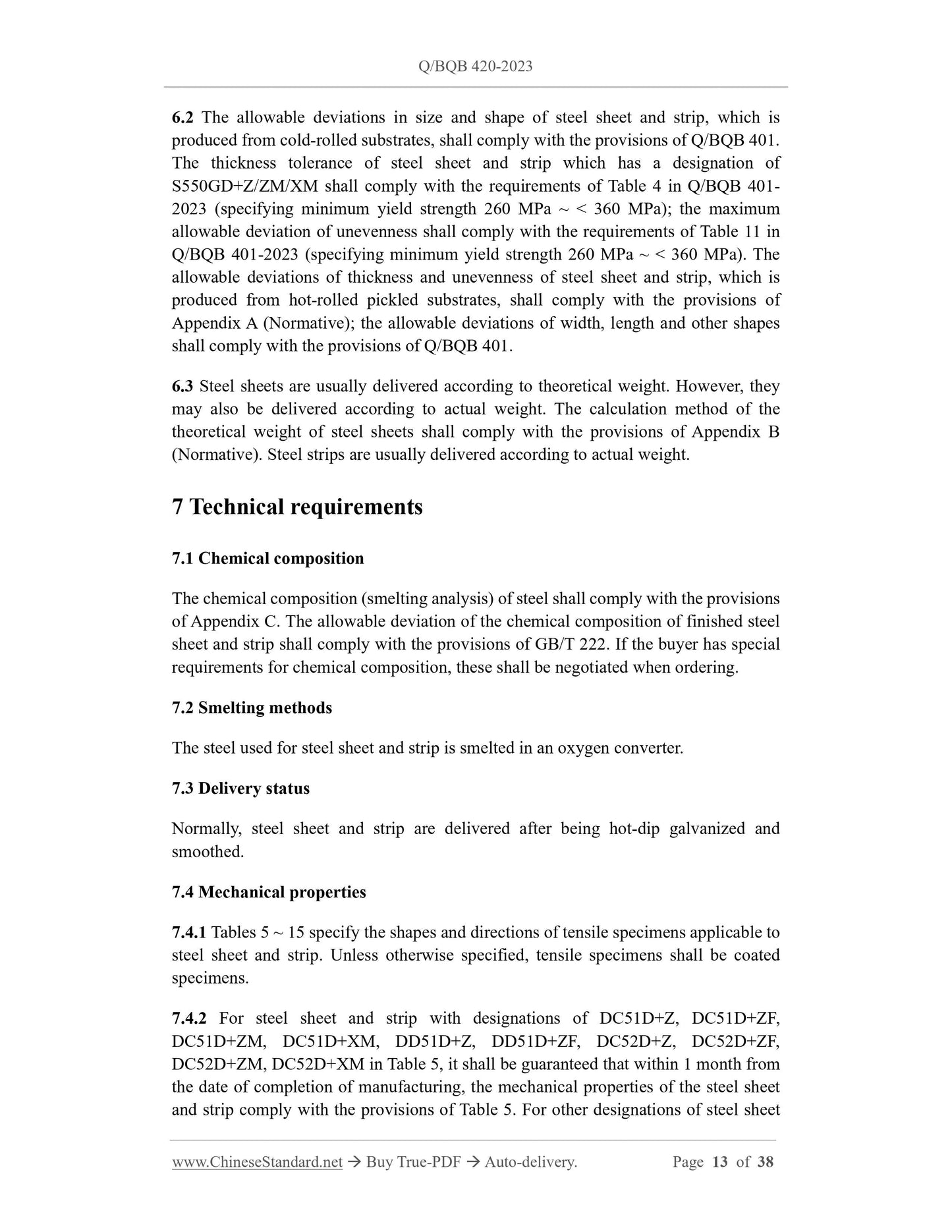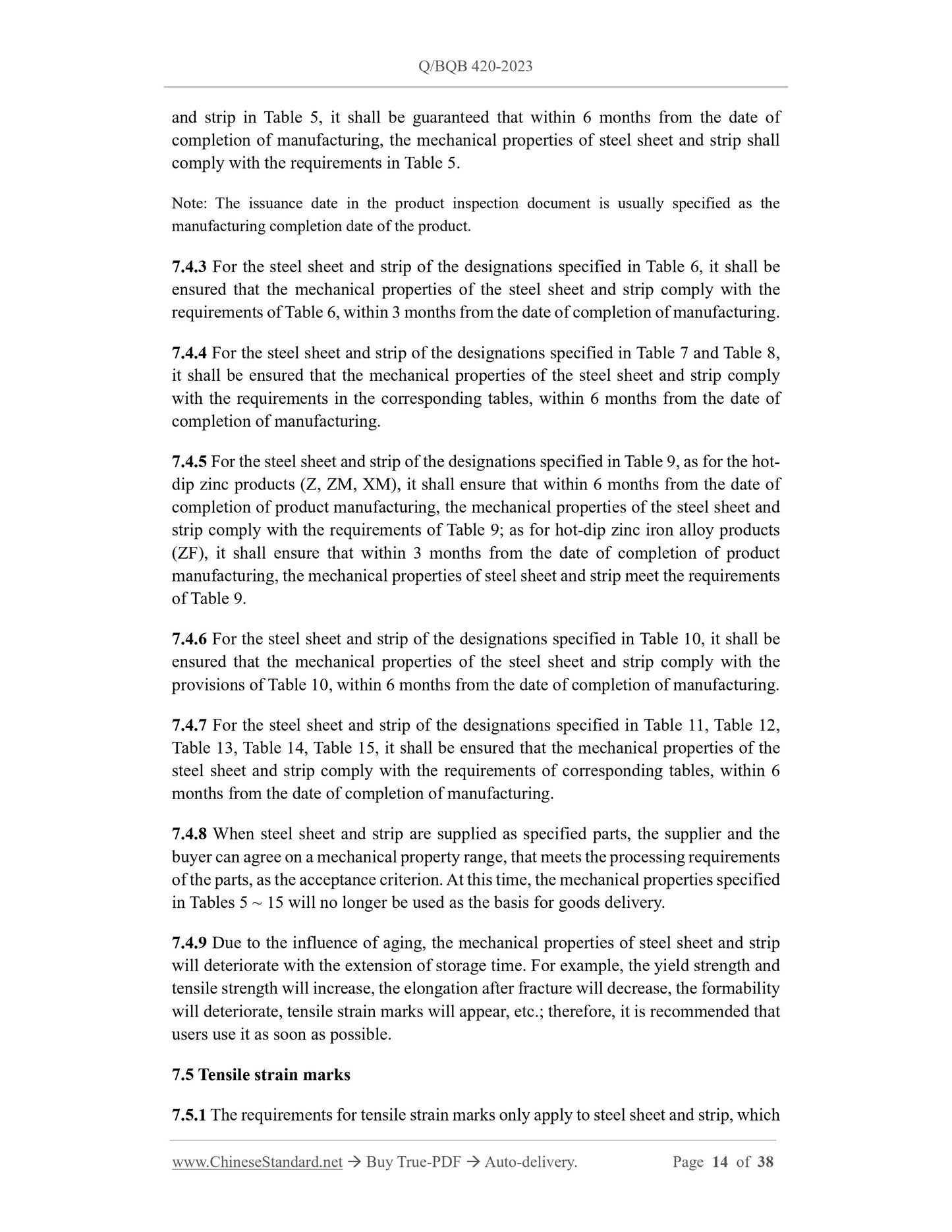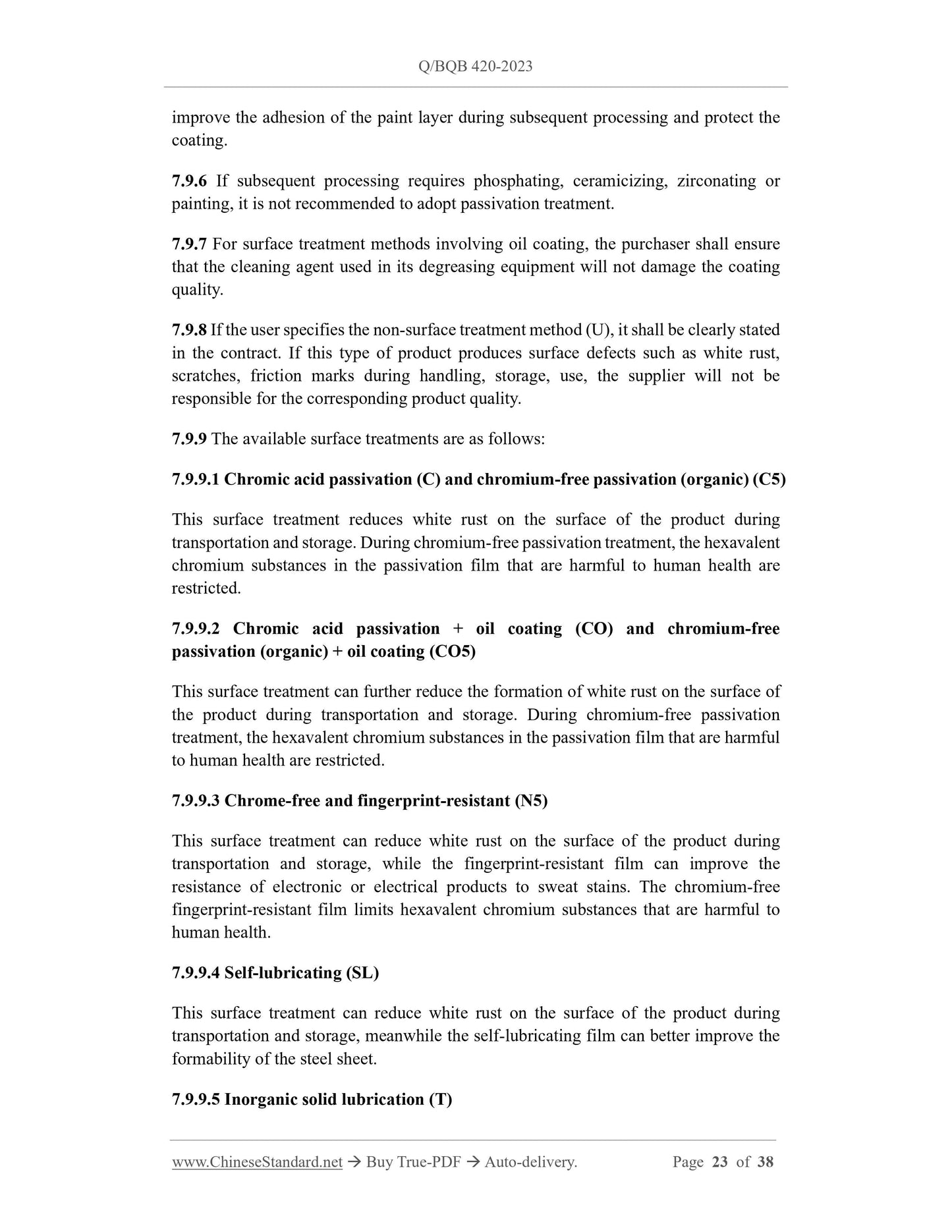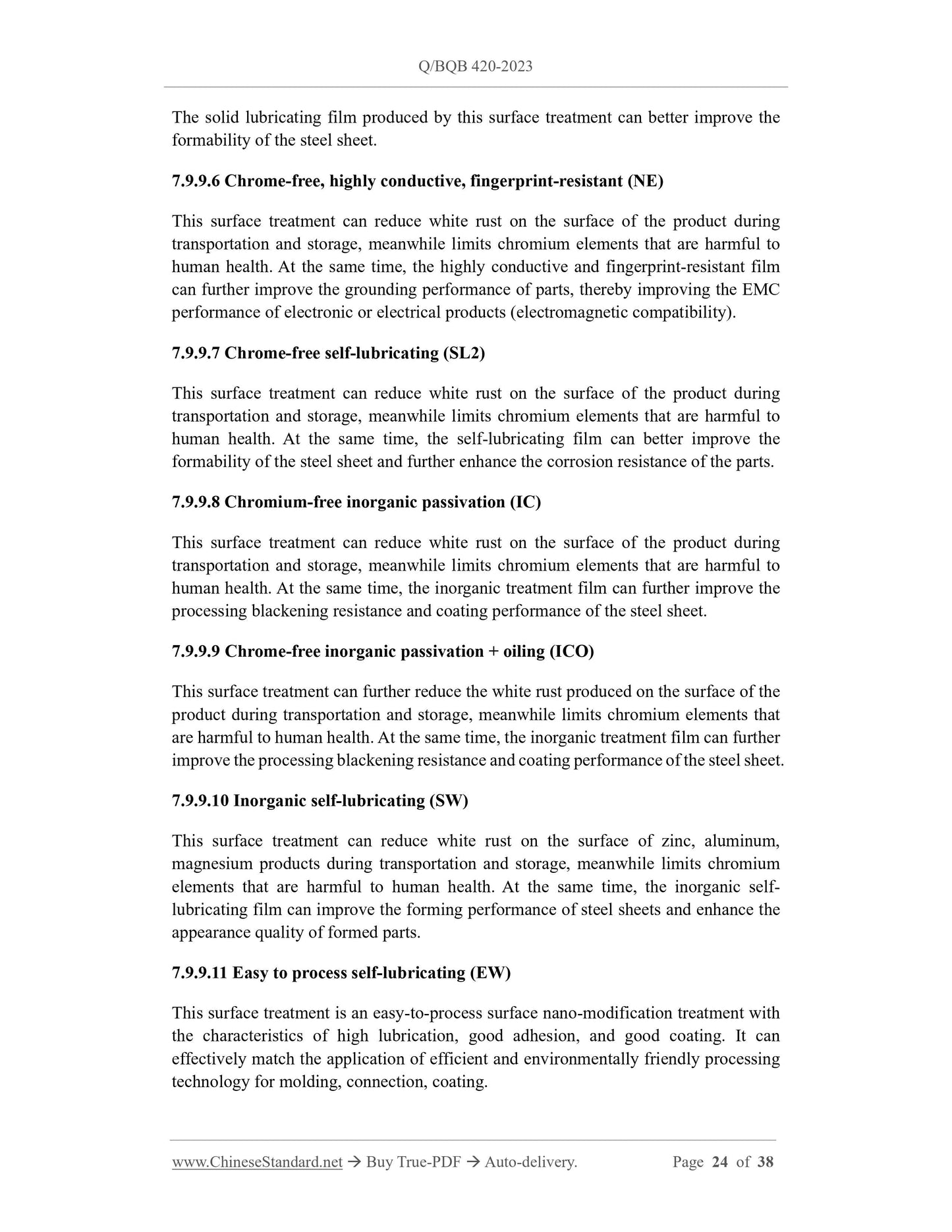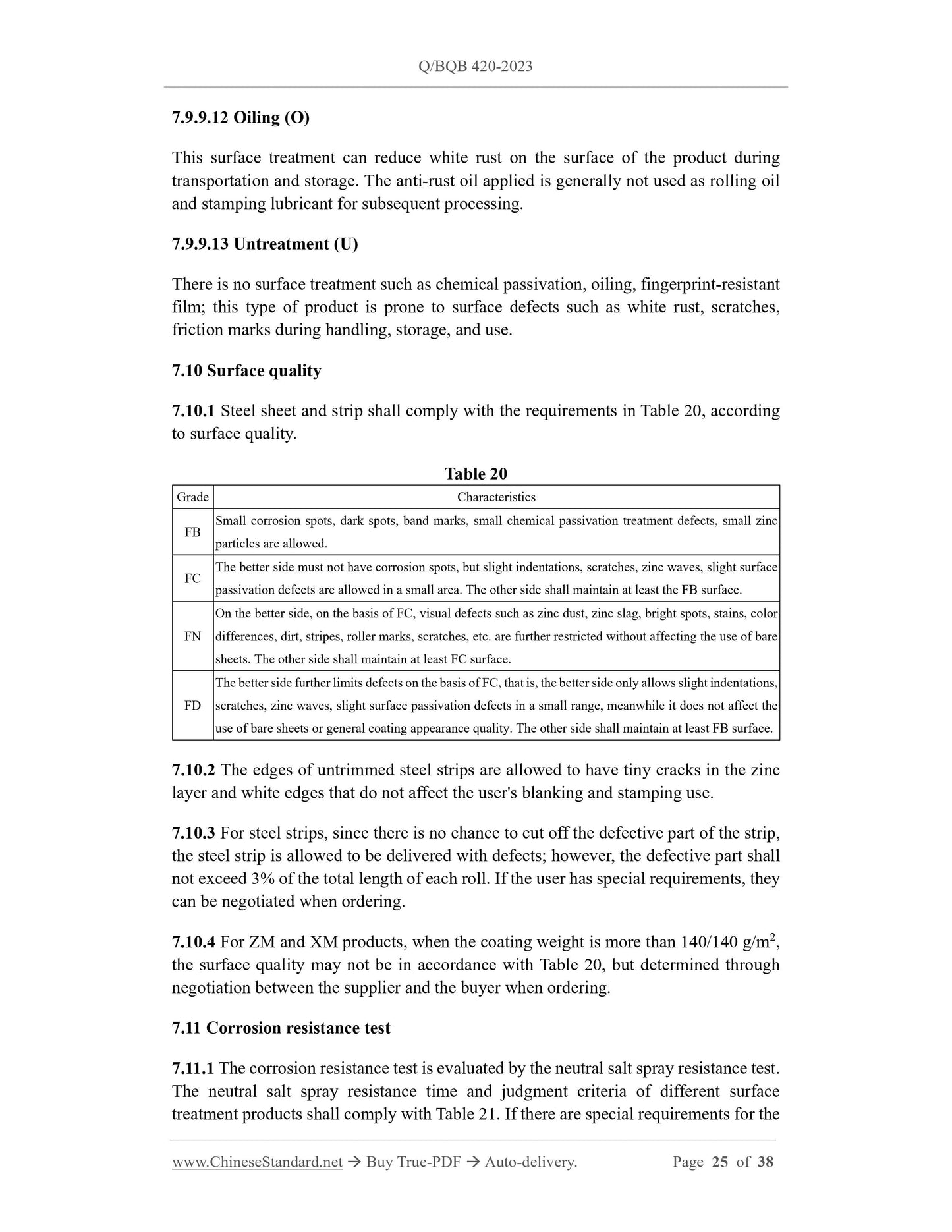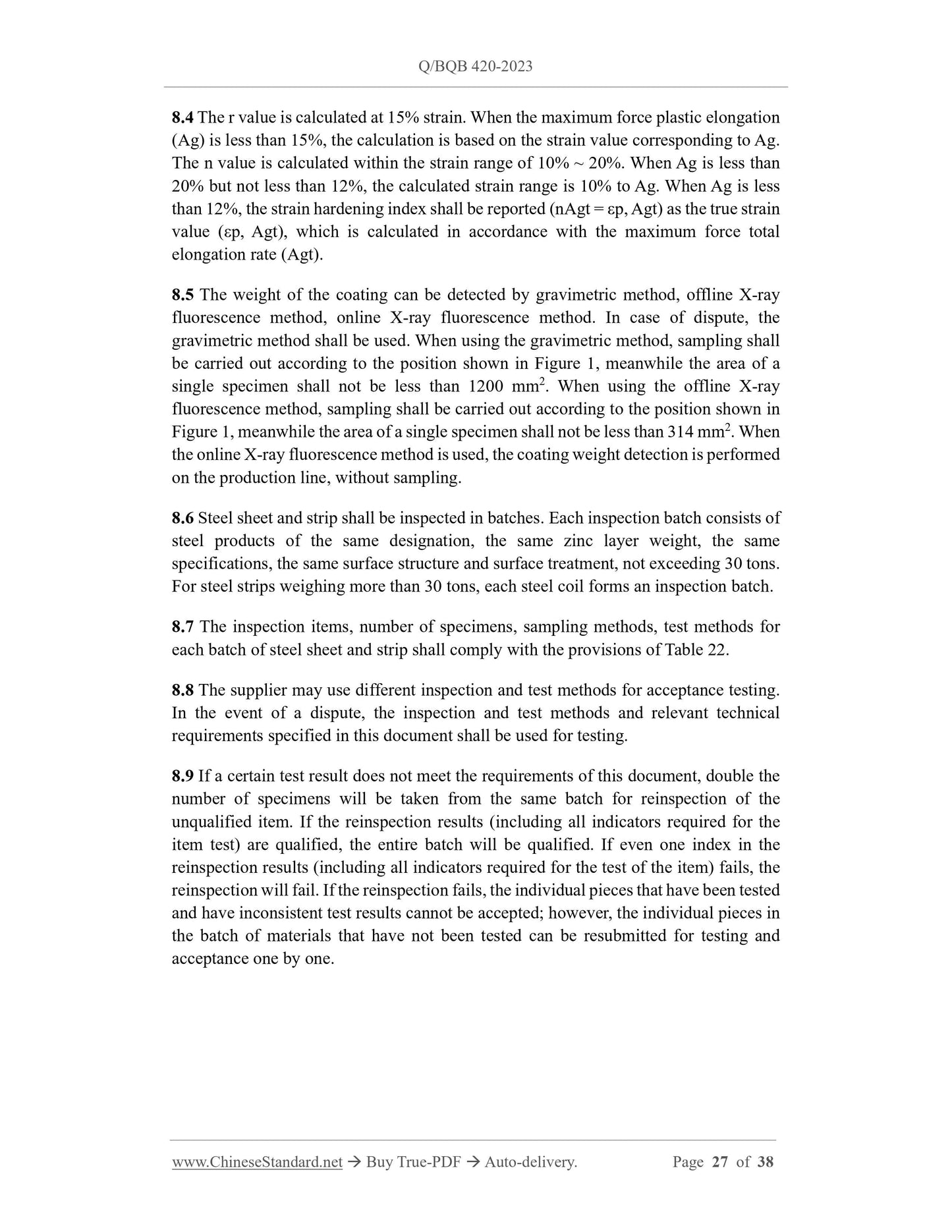1
/
of
11
PayPal, credit cards. Download editable-PDF and invoice in 1 second!
Q/BQB 420-2023 English PDF (QBQB420-2023)
Q/BQB 420-2023 English PDF (QBQB420-2023)
Regular price
$990.00 USD
Regular price
Sale price
$990.00 USD
Unit price
/
per
Shipping calculated at checkout.
Couldn't load pickup availability
Delivery: 3 seconds. Download true-PDF + Invoice.
Get QUOTATION in 1-minute: Click Q/BQB 420-2023
Historical versions: Q/BQB 420-2023
Preview True-PDF (Reload/Scroll if blank)
Q/BQB 420-2023: Hot-dip zinc /zinc-iron/zinc-magnesium/zinc-aluminum-magnesium alloy coated steel sheet and strip
Q/BQB 420-2023
BQB®
ENTERPRISE STANDARD OF BAOSTEEL CO., LTD.
Replacing Q/BQB 420-2021
Hot-dip zinc /zinc-iron /zinc-magnesium /zinc-aluminum-
magnesium alloy coated steel sheet and strip
ISSUED ON: APRIL 09, 2023
IMPLEMENTED ON: JULY 01, 2023
Issued by: BaoSteel Co., Ltd.
Table of Contents
Foreword ... 3
1 Scope ... 5
2 Normative references ... 5
3 Terms and definitions ... 6
4 Classification and code ... 9
5 Information required for ordering ... 11
6 Dimensions, appearance, weight, allowable deviations ... 12
7 Technical requirements ... 13
8 Inspection and testing ... 26
9 Packaging, marking, inspection documents ... 28
10 Numerical rounding rules ... 28
11 Comparison of similar designation ... 28
Appendix A (Normative) Permissible deviations in thickness and unevenness of steel
sheet and strip (hot-rolled pickled substrates) ... 29
Appendix B (Normative) Weight calculation method in theoretical weighing ... 32
Appendix C (Normative) Chemical composition of steel ... 33
Appendix D (Informative) Comparison of similar designations between this document
and relevant domestic and foreign documents ... 37
Hot-dip zinc /zinc-iron /zinc-magnesium /zinc-aluminum-
magnesium alloy coated steel sheet and strip
1 Scope
This document specifies the requirements for terms and definitions, classification and
codes, dimensions, appearance, weight, technical requirements, inspection and testing,
packaging, marking and inspection documents of the hot-dip zinc /zinc-iron /zinc-
magnesium /zinc-aluminum-magnesium alloy coated steel sheet and strip (hereinafter
referred to as steel sheet and strip).
This document applies to steel sheet and strip, which has a thickness of 0.23 mm ~ 4.00
mm, as produced by Baoshan Iron and Steel Co., Ltd. They are mainly used to make
internal and external covering parts and structural parts in the automobile, construction,
home appliances and other industries.
2 Normative references
The contents of the following documents constitute essential provisions of this
document through normative references in the text. Among them, for dated reference
documents, only the version corresponding to the date applies to this document; for
undated reference documents, the latest version (including all amendments) applies to
this document.
GB/T 222 Method of sampling steel for determination of chemical composition and
permissible variations for product analysis
GB/T 223 Methods for chemical analysis of iron, steel and alloy
GB/T 228.1-2021 Metallic materials - Tensile testing - Part 1: Method of test at room
temperature
GB/T 232 Metallic materials - Bend test
GB/T 1839 Test method for gravimetric determination of the mass per unit area of
galvanized coatings on steel products
GB/T 2523 Measuring method of surface roughness, peak count and waviness for
cold-rolled metal sheet and strip
GB/T 2975 Steel and steel products - Location and preparation of samples and test
3.2 Hot-dip zinc-iron alloy coating (ZF)
On a hot-dip zinc production line, the coating which is obtained by immersing pre-
treated steel strips in molten zinc. The zinc content in the molten zinc liquid shall be no
less than 99%. Subsequently, a zinc-iron alloy layer is formed on the entire coating
through an alloying process. The iron content in the alloy coating is usually 8 ~ 15%.
3.3 Hot-dip zinc-magnesium alloy coating (ZM)
On a hot-dip zinc production line, the coating which is obtained by immersing the
pretreated steel strip in a molten zinc solution containing aluminum and magnesium.
The mass percentage of magnesium in the molten zinc-magnesium alloy solution is 1.0
~ 2.0%; the mass percentage of aluminum is 0.8 ~ 3.0%; the mass percentage of other
trace control elements is less than 1%; the remaining components are zinc.
3.4 Hot-dip zinc-aluminum-magnesium alloy coating (XM)
On a hot-dip zinc production line, the coating which is obtained by immersing the
pretreated steel strip in a molten zinc solution containing aluminum and magnesium.
The mass percentage of magnesium in the molten zinc-aluminum-magnesium alloy
solution is 2.0 ~ 4.0%; the mass percentage of aluminum is 5.0 ~ 7.0%; the mass
percentage of other trace control elements is less than 1%; the remaining components
are zinc.
3.5 Interstitial free steels
Interstitial-free steel is a type of steel in which an appropriate amount of titanium or
niobium is added to ultra-low carbon steel, so that the carbon and nitrogen interstitial
atoms in the steel are completely fixed into carbon and nitride, meanwhile there are no
interstitial atoms in the steel.
3.6 High strength interstitial free steels (Y)
The plastic strain ratio (r value) and strain hardening index (n value) of steel are
improved, by controlling the chemical composition of the steel. Due to the solid
solution strengthening of the elements in the steel and the interstitial-free microstructure,
this steel has both high strength and very good cold forming properties, so it is often
used to make complex parts that require deep drawing.
3.7 Bake hardening steels (B)
A certain amount of solid solution carbon and nitrogen atoms are retained in low carbon
steel or ultra-low carbon steel, meanwhile solid solution strengthening elements such
as phosphorus and manganese may be added, to improve the strength. After processing
and forming, after baking at a certain temperature, the yield strength of the steel further
increases due to age hardening.
3.8 High strength low alloy steels (LA)
In low carbon steel or ultra-low carbon steel, micro-alloying elements such as niobium,
titanium, vanadium are added singly or in combination, to form carbonitride particles
and precipitate for strengthening. At the same time, higher strength is obtained through
the refinement of grains by micro-alloying elements.
3.9 Dual phase steels (DP)
The microstructure of steel is mainly ferrite and martensite, wherein the martensite
structure is dispersed in an island shape on the ferrite matrix. Duplex steel has a low
yield-to-strength ratio, high work hardening index, bake hardening value, which is one
of the preferred materials for structural parts.
3.10 Transformation induced plasticity steels (TR)
The microstructure of steel is ferrite, bainite, retained austenite, of which the content of
retained austenite is at least 5%. During the forming process, retained austenite can
transform into martensite structure, which has high work hardening rate, uniform
elongation, tensile strength. Compared with dual-phase steel with the same tensile
strength, it has higher elongation.
3.11 Complex phase steels (CP)
The microstructure of steel is mainly ferrite and/or bainite. On the ferrite and/or bainite
matrix, a small amount of martensite, retained austenite and pearlite are usually
distributed. By adding micro-alloying elements Ti or Nb, the effect of grain refinement
or precipitation strengthening is achieved. This steel has very high tensile strength.
Compared with dual-phase steel with the same tensile strength, its yield strength is
significantly higher. This steel has a high energy absorption capacity and a high residual
strain capacity.
3.12 Quenching and partitioning steel (QP)
Steel is a type of ultra-high-strength steel with high formability, as produced using the
quenching-partitioning process. The microstructure of steel is composed of a multi-
phase composite of martensite + ferrite + retained austenite. By utilizin...
Get QUOTATION in 1-minute: Click Q/BQB 420-2023
Historical versions: Q/BQB 420-2023
Preview True-PDF (Reload/Scroll if blank)
Q/BQB 420-2023: Hot-dip zinc /zinc-iron/zinc-magnesium/zinc-aluminum-magnesium alloy coated steel sheet and strip
Q/BQB 420-2023
BQB®
ENTERPRISE STANDARD OF BAOSTEEL CO., LTD.
Replacing Q/BQB 420-2021
Hot-dip zinc /zinc-iron /zinc-magnesium /zinc-aluminum-
magnesium alloy coated steel sheet and strip
ISSUED ON: APRIL 09, 2023
IMPLEMENTED ON: JULY 01, 2023
Issued by: BaoSteel Co., Ltd.
Table of Contents
Foreword ... 3
1 Scope ... 5
2 Normative references ... 5
3 Terms and definitions ... 6
4 Classification and code ... 9
5 Information required for ordering ... 11
6 Dimensions, appearance, weight, allowable deviations ... 12
7 Technical requirements ... 13
8 Inspection and testing ... 26
9 Packaging, marking, inspection documents ... 28
10 Numerical rounding rules ... 28
11 Comparison of similar designation ... 28
Appendix A (Normative) Permissible deviations in thickness and unevenness of steel
sheet and strip (hot-rolled pickled substrates) ... 29
Appendix B (Normative) Weight calculation method in theoretical weighing ... 32
Appendix C (Normative) Chemical composition of steel ... 33
Appendix D (Informative) Comparison of similar designations between this document
and relevant domestic and foreign documents ... 37
Hot-dip zinc /zinc-iron /zinc-magnesium /zinc-aluminum-
magnesium alloy coated steel sheet and strip
1 Scope
This document specifies the requirements for terms and definitions, classification and
codes, dimensions, appearance, weight, technical requirements, inspection and testing,
packaging, marking and inspection documents of the hot-dip zinc /zinc-iron /zinc-
magnesium /zinc-aluminum-magnesium alloy coated steel sheet and strip (hereinafter
referred to as steel sheet and strip).
This document applies to steel sheet and strip, which has a thickness of 0.23 mm ~ 4.00
mm, as produced by Baoshan Iron and Steel Co., Ltd. They are mainly used to make
internal and external covering parts and structural parts in the automobile, construction,
home appliances and other industries.
2 Normative references
The contents of the following documents constitute essential provisions of this
document through normative references in the text. Among them, for dated reference
documents, only the version corresponding to the date applies to this document; for
undated reference documents, the latest version (including all amendments) applies to
this document.
GB/T 222 Method of sampling steel for determination of chemical composition and
permissible variations for product analysis
GB/T 223 Methods for chemical analysis of iron, steel and alloy
GB/T 228.1-2021 Metallic materials - Tensile testing - Part 1: Method of test at room
temperature
GB/T 232 Metallic materials - Bend test
GB/T 1839 Test method for gravimetric determination of the mass per unit area of
galvanized coatings on steel products
GB/T 2523 Measuring method of surface roughness, peak count and waviness for
cold-rolled metal sheet and strip
GB/T 2975 Steel and steel products - Location and preparation of samples and test
3.2 Hot-dip zinc-iron alloy coating (ZF)
On a hot-dip zinc production line, the coating which is obtained by immersing pre-
treated steel strips in molten zinc. The zinc content in the molten zinc liquid shall be no
less than 99%. Subsequently, a zinc-iron alloy layer is formed on the entire coating
through an alloying process. The iron content in the alloy coating is usually 8 ~ 15%.
3.3 Hot-dip zinc-magnesium alloy coating (ZM)
On a hot-dip zinc production line, the coating which is obtained by immersing the
pretreated steel strip in a molten zinc solution containing aluminum and magnesium.
The mass percentage of magnesium in the molten zinc-magnesium alloy solution is 1.0
~ 2.0%; the mass percentage of aluminum is 0.8 ~ 3.0%; the mass percentage of other
trace control elements is less than 1%; the remaining components are zinc.
3.4 Hot-dip zinc-aluminum-magnesium alloy coating (XM)
On a hot-dip zinc production line, the coating which is obtained by immersing the
pretreated steel strip in a molten zinc solution containing aluminum and magnesium.
The mass percentage of magnesium in the molten zinc-aluminum-magnesium alloy
solution is 2.0 ~ 4.0%; the mass percentage of aluminum is 5.0 ~ 7.0%; the mass
percentage of other trace control elements is less than 1%; the remaining components
are zinc.
3.5 Interstitial free steels
Interstitial-free steel is a type of steel in which an appropriate amount of titanium or
niobium is added to ultra-low carbon steel, so that the carbon and nitrogen interstitial
atoms in the steel are completely fixed into carbon and nitride, meanwhile there are no
interstitial atoms in the steel.
3.6 High strength interstitial free steels (Y)
The plastic strain ratio (r value) and strain hardening index (n value) of steel are
improved, by controlling the chemical composition of the steel. Due to the solid
solution strengthening of the elements in the steel and the interstitial-free microstructure,
this steel has both high strength and very good cold forming properties, so it is often
used to make complex parts that require deep drawing.
3.7 Bake hardening steels (B)
A certain amount of solid solution carbon and nitrogen atoms are retained in low carbon
steel or ultra-low carbon steel, meanwhile solid solution strengthening elements such
as phosphorus and manganese may be added, to improve the strength. After processing
and forming, after baking at a certain temperature, the yield strength of the steel further
increases due to age hardening.
3.8 High strength low alloy steels (LA)
In low carbon steel or ultra-low carbon steel, micro-alloying elements such as niobium,
titanium, vanadium are added singly or in combination, to form carbonitride particles
and precipitate for strengthening. At the same time, higher strength is obtained through
the refinement of grains by micro-alloying elements.
3.9 Dual phase steels (DP)
The microstructure of steel is mainly ferrite and martensite, wherein the martensite
structure is dispersed in an island shape on the ferrite matrix. Duplex steel has a low
yield-to-strength ratio, high work hardening index, bake hardening value, which is one
of the preferred materials for structural parts.
3.10 Transformation induced plasticity steels (TR)
The microstructure of steel is ferrite, bainite, retained austenite, of which the content of
retained austenite is at least 5%. During the forming process, retained austenite can
transform into martensite structure, which has high work hardening rate, uniform
elongation, tensile strength. Compared with dual-phase steel with the same tensile
strength, it has higher elongation.
3.11 Complex phase steels (CP)
The microstructure of steel is mainly ferrite and/or bainite. On the ferrite and/or bainite
matrix, a small amount of martensite, retained austenite and pearlite are usually
distributed. By adding micro-alloying elements Ti or Nb, the effect of grain refinement
or precipitation strengthening is achieved. This steel has very high tensile strength.
Compared with dual-phase steel with the same tensile strength, its yield strength is
significantly higher. This steel has a high energy absorption capacity and a high residual
strain capacity.
3.12 Quenching and partitioning steel (QP)
Steel is a type of ultra-high-strength steel with high formability, as produced using the
quenching-partitioning process. The microstructure of steel is composed of a multi-
phase composite of martensite + ferrite + retained austenite. By utilizin...
Share
